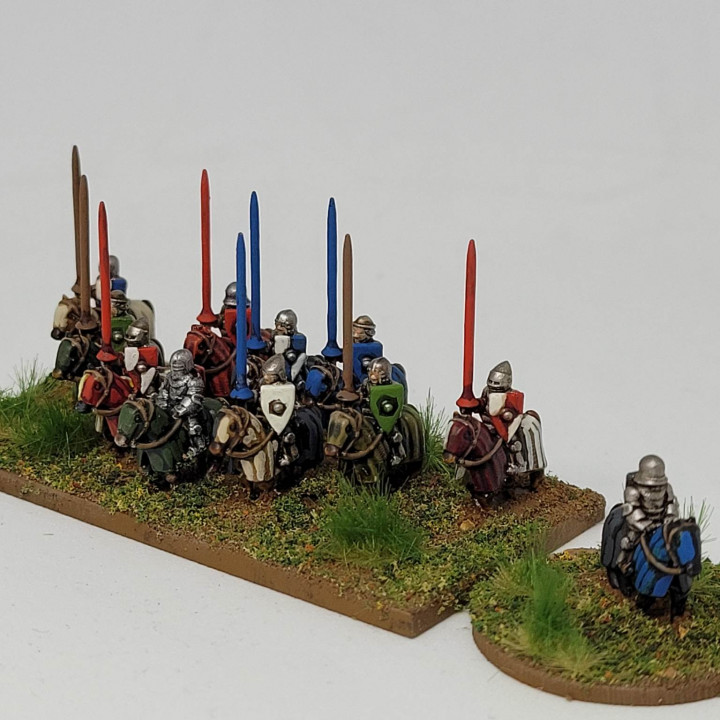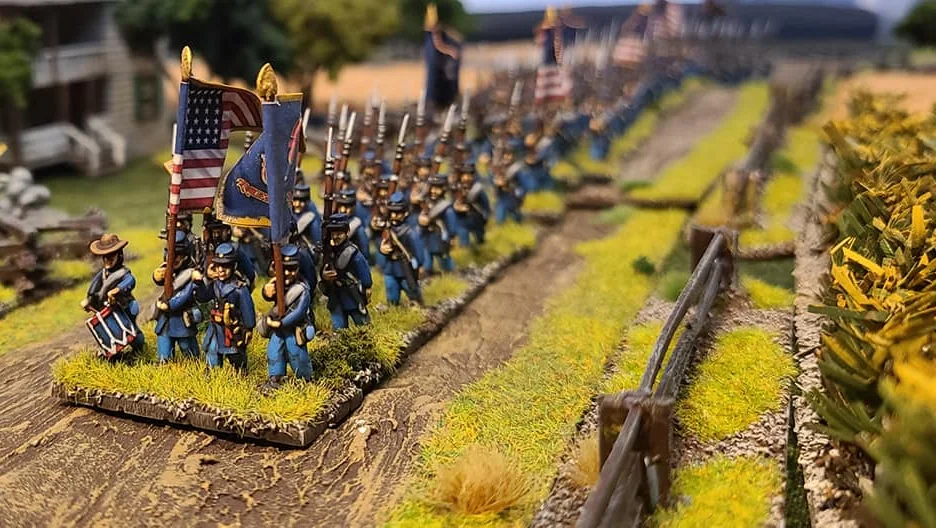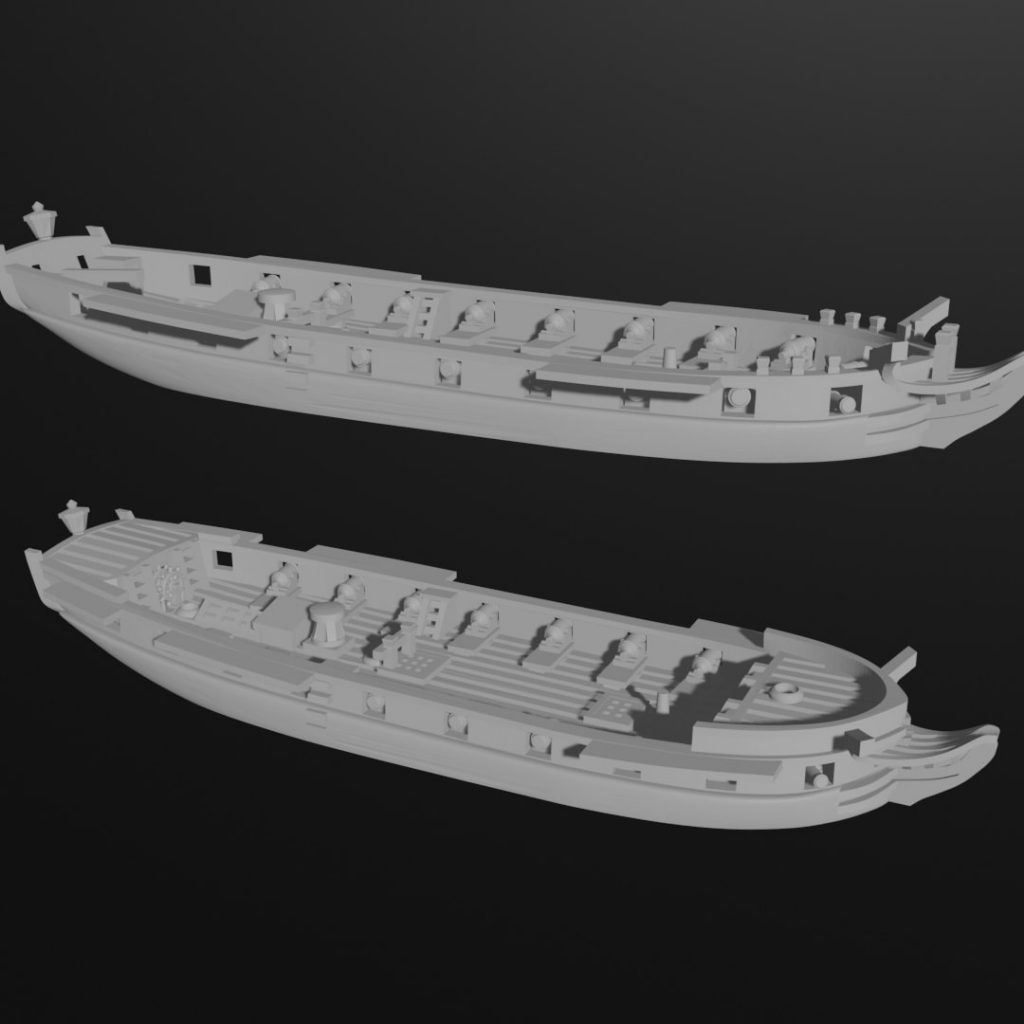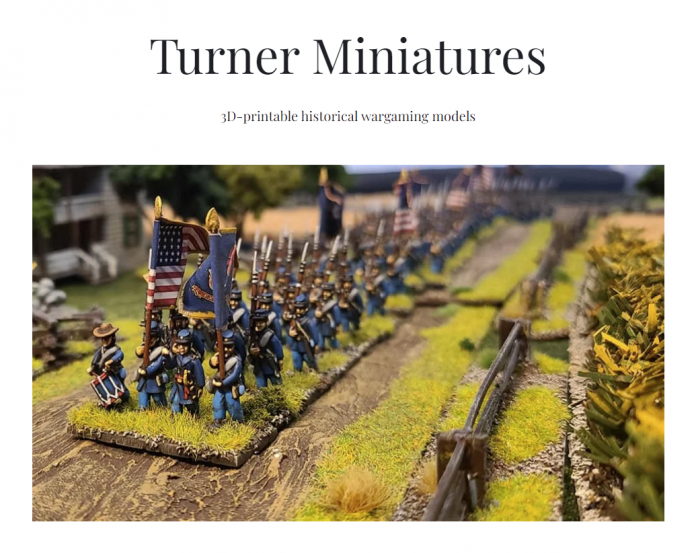With the Year of the Ship in full swing, Lenoon got in touch with ship-STL maestro Henry of Turner Miniatures to chat all things digital sculpting, historicals and 3d printing.
Lenoon: Starting off easy, can you tell us a little about yourself and where we can find you?
Henry: My name’s Henry and I run Turner Miniatures. I’ve been designing 3D-printable historical wargaming STLs for just over four years now. Most of my work’s been small-scale figures and 1-700 & 1-1200 ships. My models are listed in my catalogue, with STLs being sold on MyMiniFactory and Wargaming3D, while physical prints can be bought from OnlyGames.
I also run a Tribe on MyMiniFactory and a Patreon, which both allow patrons to get my newest models each month, and vote on what I should make next. Finally, I’ve lots of tutorials on my YouTube channel showing folks my work and how to use my Blender files.
Lenoon: How did you get into Wargaming in the first place?
Henry: I think I followed the standard pipeline that’s typical of a Brit in their early 30s; I got suckered into Wargaming by Games Workshop and Warhammer and learned all my painting and hobbycraft from the freely available ‘Eavy Metal guides they used to have on their site (why did they take those down?!). By the end of University I had something like five 40k and three Warhammer Fantasy Battle armies.
Unfortunately I don’t really have the attention span to be much of a proper wargamer, but it’s the spectacle of the hobby that’s always been attractive to me; bright colours of characterful miniatures clashing off against one another. I think that’s why I’ve always been more of a collector than a gamer! When I do actually play, I generally gravitate toward what the Grognards might dismiss as the “casual” rulesets. Heaven forbid a game might be finished in less than an afternoon!
As for how I got into historicals – I think it was just natural. I’m a history graduate, love period films and am prone to daydreaming. Once I picked up collecting and painting miniatures as a hobby, I of course wanted to start painting and modelling stuff that I was more broadly interested in.

In Russia my local club played Flames of War (a game I have to admit I am not at all a fan of) and I managed to rope some of the guys there into trying out Black Powder and Napoleonics with me. It wasn’t easy (or cheap) to get miniatures out there, so we used what was locally available; lots of 1/72s! I think that was my first proper go at historicals, outside of painting up some WW2 stuff for fun.
Lenoon: Could you give us a quick intro to Turner Miniatures?
Henry: I suppose the general aim of the brand has been to transition what’s currently on offer from “physical” manufacturers over to the 3D-printing space, which remains a bit of a Frontier with some big blindspots.
While it’s certainly possible to find bits-and-bobs from all sorts of periods around the internet, I wanted to create a sort of one-stop shop for modelling most of what you’re going to need to collect a whole force for a given conflict, all created to the same standard and in a similar style. I also do my best to make my models simple to print or, ideally, print totally supportless as life is short and too precious to be spent on intricately supporting every model you want to print!
Once I’ve sets for every conflict listed on Plastic Soldier Review, I’ll consider myself ready to retire!

Another thing that’s set me apart from competition is the fact that I often offer the original Blender files or dedicated Blender exporters alongside my work. The idea there is to offer small-scale wargamers the same sort of customisation that they’d be able to get out of a multi-part 28mm kit (with an array of options for clothing, heads and equipment or, in the case of ships, tweaking masts, sails, gunwhales galleries and other “toggleable” parts). While I think most people are in it for the STLs, the Blender files do have a smaller very dedicated following among my customers.
Lenoon: How did you start with 3d Sculpting?
Henry: I found myself “trying” Blender a few times during my teen years, mostly with an idea for modding or video game design. So by the time I first tried sculpting ships, I knew some of the principles and controls but generally had no idea what I was doing.
Like many, I only really started getting to grips with things by following the famous “Donut Tutorial” on YouTube. From there it was a lot of trial-and-error and seeking out help from established creators!
Beyond that help I’ve had from others, it’s otherwise been a trial-and-error learn-by-doing sort of experience. My early work is, in my opinion, of a noticeably worse quality and backers of my initial Napoleonic models will probably quite readily tell you it’s quite frustrating that I didn’t decimate my meshes back then (mind you, in the 28mm space, it seems like nobody does either!). I find myself cringing watching some of my older videos as I do lots of silly things like copying-and-pasting assets to a separate file prior to exporting because I didn’t know there was a “Selection Only” button on the Export Window!
More recently I’ve been learning 28mm sculpting in my free time and come across all sorts of stuff I’d never used before like Multires modifiers so the learning never really stops, I suppose. In honesty, one of my biggest anxieties about the future is getting too stuck in my ways. I think that, when you have a good formula going, it could be easy to just keep releasing variations of the same stuff again and again. The issue could be compounded if your fans like that style and ask you to keep releasing more of the same; the potential for stagnation is immense! So I’m very much inclined toward the odd risky move.
Lenoon: How do you choose which ranges to work on? (and a follow up – your release schedule is crammed! how do you organise your workflow for new sculpts?)
Henry: I have to confess that, over the years, I’ve been a bit all over the place with this! One thing I learned very early on is that it’s a bad idea to lay out a concrete multi-year release schedule/plan as you can’t predict what’s going to happen or how you might feel down the line.
As an individual creator doing all this by myself, it’s been important to try balance what my customers tell me they want, what will sell well generally and what I personally find interesting/creatively fulfilling. My choice of crowdfunded projects (namely Kickstarters) hopefully reflects this!

For more day-to-day stuff, though, I run both a MyMiniFactory Tribe and a Patreon where my customers get to vote on models I’ll make for a particular month or quarter. At the time of writing, I’m working on part three of a Franco-Prussian War “Mini Range,” Napoleonic Freikorps figures and three of the “Original Six” US Navy Frigates; all of which were selected by popular vote.
My next upcoming crowdfunded range is the American War of Independence, which was selected solely by myself as a period I’m very interested in. It’s following on from Waterloo, which I made as more of a “crowdpleaser,” and am nowhere near as personally into.
Lenoon: 3D sculpted ranges have exploded over the last few years; where do you see 3D print/sculpts going in the future?
Henry: We’ve finally reached a point, I feel, where 3D printing is shaking off that image it got in the early days of folks sharing crude fuzzy images of FDM-printed Space Marine “Dreadnoughts” that were flash galore. Your average wargamer now seems more aware of the distinction between resin and FDM, and many of them have seen the detail the former’s capable of firsthand. Add to that the explosion of affordable home printers and this sub-hobby’s more accessible and gaining more exposure than ever before. With a printer and a bit of patience, there’s really nothing stopping you from getting anything you want out of your mind’s eye and onto your painting table.
I think 3D prints are also democratising the wargaming space to an extent. As many creators are individual designers, we’re generally easier to get hold of and much more responsive to customers’ wishes. We’re also seeing an ever-growing cottage industry of local printing shops, which I expect will continue to spread and service those who are unable or unwilling to get a printer for themselves.

It wouldn’t surprise me if, in the near future, the wargaming space consisted almost entirely of injection-moulded plastic models and 3D prints. I think that metal miniatures and cast resin are likely to go the way of the dodo as material costs rise and the directors of these businesses retire with nobody buying out their companies.
A further comment that I fear might not make me many friends is that, to be brutally honest, resin prints produce superior detail in the smaller scales. 6mm and 1/1200 metal castings just don’t look as crisp and can’t produce the same small bits that a printer can. A printed 6mm figure has a distinct fact with eyes and a mouth, while a 1/700 ship has individual window panes!
Lenoon: What’re some of the biggest challenges you’re facing in the industry as a 3D sculptor?
Henry: The big obvious one is piracy. There just isn’t a way to stop people from sharing your work. Platforms like Telegram have huge groups where people freely distribute models among themselves. Another offender are subscription sites that collect dozens or hundreds of monthly Patreon releases and share all of them with their own subscribers at a huge discount.
Unfortunately there’s little we can do and creators just have to console themselves with the likelihood that the sorts of people who steal work were unlikely to buy it in the first place.
Beyond that, there’s still some (minor) hostility to 3D prints in general. Some folks just prefer metal, which is fair enough – prints do lack that satisfying “weight” to them!
Finally, there’s the fact that renders of models on a computer screen look quite different from the actual printed item. My too-easily-bruised ego has been damaged a bit when sharing snapshots of 6mm models I’m working on only to be told they look like hobbits!
Lenoon: Onto the Ships! What prompted the Age of Sail range?
Henry: I began sculpting ships when I was living in Russia, working as an English teacher. I really fancied painting up some ships for the first time but the only option at the time was Langton minis, which were both too small for my liking (sorry 1/1200 fans!) and quite expensive to get out to Siberia.
I figured I could try make some for myself, so I tried sculpting on Blender and failed completely… this led to me making some 1/900 models out of balsa wood but, being dissatisfied with the result, I returned and kept throwing myself at Blender. I was very, very fortunate to come across Simon Mann, another creator, who was making his own range of 1/700 ships. He was gracious enough to offer me feedback and advice, even going so far as critiquing the ships I was coming up with individually. It was at his suggestion that I uploaded those initial designs to Wargaming3D so, really, I think I have him to thank for everything I’ve managed since! My first Kickstarter, Gilded Sails, was in January 2020 and the rest is history, really.

Lenoon: Could you explain the Blender exporter system and why you went for it?
Henry: I think the Blender files are one thing that I do a very poor job of explaining in general! So I’m glad to give it another go. The concept is perhaps best viewed as a video, though.
Blender is a freely available programme used in 3D design work and animation, and is what I use to make all of my models. The Blender “Exporters” are my attempt to take my original files and convert them into a user-friendly version that allows people to produce their own custom models using various “toggles” (e.g. for different hats, coat types, cuffs, legs and all sorts).

Of course, that’s only really scratching the surface. While the toggle functions are meant to cater to the novice user, someone who really knows what they’re doing can get all sorts of mileage out of having the original files available to them. I suppose the way to visualise the difference is to realise that, if you buy a creator’s STL files, you get a model comprised of a single mesh that is much harder to customise. You can rescale it, but any scaling changes you make will be applied to the whole model.
When you buy a Blender file, you get my models in all their constituent “pieces” – each strap, hat plume, boot and anything else is a separate object. This means if you’re willing to learn some basic controls and get into the nitty gritty with things, you have a lot of scope for changing things. Beyond scaling you can try your hand at sculpting tools, modifying meshes and all sorts!
While I’d love to toot my own horn and say that this is all about democratising miniature design; the truth is that I thought it was a cunning way to preclude niche requests. When someone sends you a message like “Henry, have you ever considered modelling Cuthbert’s 2nd Company of the Strudelgruber Regiment? They’re essential for modelling the cabbage patch skirmish at Miggins’ Pie Shed! Please be sure to include their distinctive 9-buttoned single-breasted long coats and L-shaped feather plume atop their Croatian chefs’ hats” I’d be able to say “Not sure I can get around to that one, but you’re welcome to kitbash it for yourself!”

Taking this same system and applying it to my ships is a more recent development but it follows roughly the same principle. By having different options on ships like galleries, bows, weapon armaments, gunwhales and railings all be different toggleable “bits,” it means people can get a lore more mileage out of a single ship purchase and model multiple individual vessels. For example, my British “Common” 3rd rates are intended to cover five separate vessel classes!
Lenoon: Amazing – I’ll be printing some for my fleets, any advice on how to print them for Black Seas?
Henry: An issue I think Black Seas players can have approaching alternative 1/700 ships and prints is that their prior experience is often just with Warlord’s minis. Unfortunately it seems to me that, despite advertising their range as being 1/700 scale, Warlord ships actually use a sliding scale wherein it’s only the actual Ships of the Line that are “truescale” 1:700s, with smaller frigates and unrated ships getting bigger and bigger.
It’s a lucky thing, then, that one freedom 3D printing gives you is the ability to freely rescale your models! In my experience, a 1:700 5th rate printed at around 1/620 will closely match a Warlord Frigate, while you want your Brigs and other unrated vessels to be printed around 1/500 if you want your collection to be in-line with Warlord’s range.

I can’t speculate with any authority as to why Warlord chose this approach but I suppose a charitable guess would be that, since Black Seas is a ruleset that looks to cover smaller clashes outside typical 1st-3rd rate slog matches, they perhaps wanted smaller ships to still feel “weighty” on the table, and be fun to put together, paint and not easily break!
Thanks for all that Henry – looking forward to diving into Blender and prints for my French and Americans! If you’d like to see more of Henry’s work, check out Turner Miniatures, MyMiniFactory and Wargaming3D, or for the printer-less, OnlyGames.
Questions, comments, suggestions? contact@goonhammer.com or leave a comment below.


